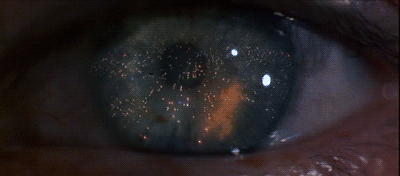What they came up with resembles taking this ...
... and putting it in this.
Now I was actually curious enough that I watch all four episodes that were produced before it was cancelled. As long as I could watch it and pretend they were using different names, I was good. The show wasn't bad in and of itself, but it certainly wasn't Dirk Gently.
For example, in the book we have this description of the title character ...
"Svlad Cjelli, infamously known as Dirk. ... He was rounder than the average undergraduate and wore more hats. That is to say, there was just the one hat which he habitually wore, but he wore it with a passion that was rare in one so young. The hat was dark red and round, with a very flat brim, and it appeared to move as if balanced on gimbals, which ensured its perfect horizontality at all times, however its owner moved his head. As a hat it was a remarkable rather than entirely successful piece of personal decoration. It would make an elegant adornment, stylish, shapely and flattering, if the wearer were a small bedside lamp, but not otherwise."
And this ...
"He wore a heavy old light brown suit which looked as if it had been worn extensively for bramble hacking expeditions in some distant and better past, a red-checked shirt which failed entirely to harmonize with the suit, and a green stripped tie which refused to speak to either of them. He also wore thick metal-rimmed spectacles, which probably accounted at least in part for his dress sense."
So someone read all of that and then came up with this ...
So - okay making Dirk more visually appealing for a mass audience (or as one reviewer put it ... "Purists may grumble that this isn't the Dirk Gently they wanted to see but its more accessible and practicable") can be a somewhat reasonable approach. But they also changed much of his personality and basically created a generic detective show with sci fi elements.
I was rather disappointed, but going to leave it at that ... and then last night I finally got a chance to see the first episode of Sherlock. Yes - I am an Earth Sciences professor. I really do live under a rock. See ...
Low and behold ... I found out that Dirk was the low budget version of this ...
excised
much of the book’s budget-swallowing imagination into something
achievable on a frugal budget; bringing the idea down-to-earth as an
eccentric cousin to the BBC’s Sherlock update. Purists may grumble this
isn’t the Dirk Gently they wanted to see, but it’s more accessible and
practicable.
Read more at http://whatculture.com/tv/tv-review-dirk-gently.php#AODbJczhf0oKVKvI.99
Read more at http://whatculture.com/tv/tv-review-dirk-gently.php#AODbJczhf0oKVKvI.99
excised
much of the book’s budget-swallowing imagination into something
achievable on a frugal budget; bringing the idea down-to-earth as an
eccentric cousin to the BBC’s Sherlock update. Purists may grumble this
isn’t the Dirk Gently they wanted to see, but it’s more accessible and
practicable.
Read more at http://whatculture.com/tv/tv-review-dirk-gently.php#AODbJczhf0oKVKvI.99
Read more at http://whatculture.com/tv/tv-review-dirk-gently.php#AODbJczhf0oKVKvI.99
excised
much of the book’s budget-swallowing imagination into something
achievable on a frugal budget; bringing the idea down-to-earth as an
eccentric cousin to the BBC’s Sherlock update. Purists may grumble this
isn’t the Dirk Gently they wanted to see, but it’s more accessible and
practicable.
Read more at http://whatculture.com/tv/tv-review-dirk-gently.php#AODbJczhf0oKVKvI.99
Read more at http://whatculture.com/tv/tv-review-dirk-gently.php#AODbJczhf0oKVKvI.99
excised
much of the book’s budget-swallowing imagination into something
achievable on a frugal budget; bringing the idea down-to-earth as an
eccentric cousin to the BBC’s Sherlock update. Purists may grumble this
isn’t the Dirk Gently they wanted to see, but it’s more accessible and
practicable.
Read more at http://whatculture.com/tv/tv-review-dirk-gently.php#AODbJczhf0oKVKvI.99
Read more at http://whatculture.com/tv/tv-review-dirk-gently.php#AODbJczhf0oKVKvI.99
excised
much of the book’s budget-swallowing imagination into something
achievable on a frugal budget; bringing the idea down-to-earth as an
eccentric cousin to the BBC’s Sherlock update. Purists may grumble this
isn’t the Dirk Gently they wanted to see, but it’s more accessible and
practicable.
Read more at http://whatculture.com/tv/tv-review-dirk-gently.php#AODbJczhf0oKVKvI.99
Read more at http://whatculture.com/tv/tv-review-dirk-gently.php#AODbJczhf0oKVKvI.99
excised
much of the book’s budget-swallowing imagination into something
achievable on a frugal budget; bringing the idea down-to-earth as an
eccentric cousin to the BBC’s Sherlock update. Purists may grumble this
isn’t the Dirk Gently they wanted to see, but it’s more accessible and
practicable.
Read more at http://whatculture.com/tv/tv-review-dirk-gently.php#AODbJczhf0oKVKvI.99
Read more at http://whatculture.com/tv/tv-review-dirk-gently.php#AODbJczhf0oKVKvI.99
I mean seriously - the personality quirks, visualization of clues, the dynamics with "Watson," the hair ... it is disturbing.
I think the thing that bugs me the most is that there are a variety of ways of being highly intelligent and socially inept. Just walk around my building and meet the faculty. I am sick to death of the genius jerk being the only version that we ever see. Why did they have to take all the things that made Dirk interesting and basically make him Sherlock with an added sleaze factor ??? Argh ! And the whole, you can't avoid comparisons with Sherlock Holmes if you are doing a detective show, piffle. YES YOU CAN! Give them a different personality! Good grief!
On the plus side ... now I get to watch Sherlock !!! Cool ! I quite liked the first episode and John.
Slightly spoilery - but
... did anyone else wave at the screen saying, I'm familiar with Princess Bride. I know that trick.
Overman
has wisely excised much of the book’s budget-swallowing imagination
into something achievable on a frugal budget; bringing the idea
down-to-earth as an eccentric cousin to the BBC’s Sherlock update.
Purists may grumble this isn’t the Dirk Gently they wanted to see, but
it’s more accessible and practicable. And while Dirk Gently is certainly
another gimmicky detective series (yawn), its details are unique and
engrossing enough to shrug off the genre’s clichés.
Read more at http://whatculture.com/tv/tv-review-dirk-gently.php#AODbJczhf0oKVKvI.99
Read more at http://whatculture.com/tv/tv-review-dirk-gently.php#AODbJczhf0oKVKvI.99

















































